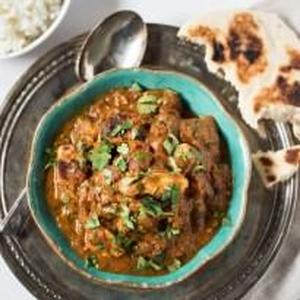Chicken Tikka Masala

Prep Time
Cook Time
Total Time
Last week I posted a recipe for naan, an Indian leavened flatbread. So it only seemed appropriate to make an entrée to compliment the soft, pillowy bread I just made. Chicken Tikka Masala is guaranteed to be on the menu of every Indian restaurant, but is it Indian?
The history of this Anglo-Indian dish is long and varied, but through some research I've tried to condense things for you. In India, when agriculture first began to take hold, chickens were cultivated, prepared, and cooked in a tandoor (a large cylindrical clay oven). The small roasted pieces that we know as 'tikka' were actually born out of the paranoid behavior of emperor Babur, founder of the Mughal dynasty in South Asia almost 500 years ago. He was so concerned with choking on a chicken bone, that he ordered his chefs to remove all bones before being cooked in the tandoor.
Over time, chicken tikka came to be marinated in yogurt and spices. During British rule, aspects of Indian food, such as curry, became popular in British cuisine. However, it wasn't until a large immigration movement in the 1950s from India to the UK, that Indian restaurants began sprouting up and chicken tikka made its way onto local plates.
